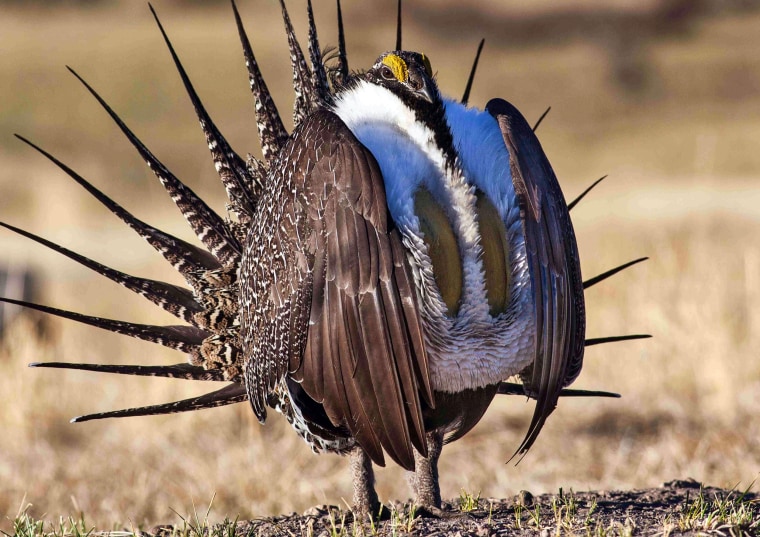A House provision in the annual military spending bill is ruffling feathers in Congress.
At issue is the greater sage grouse, a stout bird whose dwindling population tends to live in areas of the United States that are rich in oil, gas, and ranches. The 11 states it inhabits also have a number of military training grounds in them.
Debate over the fate of the feathered fowl has stymied congressional leaders who had hoped to pass the 2017 National Defense Authorization Act by this week.
The bird's speckled body, stumpy feet, and flashy mating routine have earned it hundreds of thousands of views on YouTube — but the animal isn't quite as popular among some politicians, who feel federal protections for it go too far. As a result, a House rider was added to the defense bill that would block the Secretary of the Department of Interior from elevating the conservation status of the sage grouse to endangered through 2026.
"It is not an endangered species, but any kind of changes to the land management plan that would reflect it as endangered and would take authority away from the states would curtail military readiness and harm military readiness," said Republican Rep. Rob Bishop of Utah, Chairman of the House Committee on Natural Resources, who is behind the rider.

This isn't the first time the fowl has run afoul of divided interests.
Last year, following a passionate debate between environmentalists and pro-business proponents, the U.S. Fish and Wildlife Service opted not to add the bird to its endangered species list, a move that would have virtually shut down huge swaths of land to other uses in the states where it resides.
Related: The $5.6 Billion Bird: How Will The Sage Grouse Fight End?
Now, the sage grouse is again at the center of a heated argument, this time deadlocking congressional leaders.
Politicians say the NDAA bill, a massive military spending measure, is almost done — but is being held up by the Bishop's rider.
While it's not currently listed as endangered, the bird does enjoy some federal protections.
Bishop's rider would give states' governors the power to override certain the current conservation efforts, something many, particularly in red states, are eager to do.
"This is a provision that has nothing to do with the Department of Defense."
To those who argue a busty bird doesn't belong in a defense policy bill, Bishop says, "It is a military issue, despite what some might say."
"It does have a significant impact and already has had an impact on military readiness, especially the ranges," Bishop told NBC News, adding federal protection laws around it have forced the Army in Washington state and Utah, for example, to cut back on their activity at military testing ranges "based on the bird."
"There's absolutely no justification for not putting it in the bill," he said. "This has the potential of being true harm for our military."
But Rep. Adam Smith of Washington, the top Democrat on the House Armed Services Committee, called that "clearly untrue" and said senior military officials have debunked the idea that protecting the sage grouse impacts military readiness.
"This is a provision that has nothing to do with the Department of Defense. It's, frankly, just dishonest," Smith told NBC News.
Instead, he said, those behind the rider are trying to protect oil and gas interests in their states. A study from 2014 estimates declaring the sage grouse endangered would cost the U.S. $5.6 billion in economic output.
Utah is an oil-rich state. According to Open Secrets, a non-profit that analyzes the influence of money in politics, the oil industry has generously donated to Bishop's campaigns.
"This cycle so far, he has received more from the energy and natural resources sector, $165,000, than he did in the entire 2014 cycle, $150,500," the organization said in a report published earlier this year.
Bishop's communication director denied donors had anything to do with the rider and reiterated the defense benefits the congressman touted.
"Donations from anywhere are not going to influence the decisions he makes here in Congress," Lee Lonsberry said.
For activists, the bigger concern is environmental consequences for the sage grouse, which is considered an "indicator species" because its ability to thrive is indicative of how others in the landscape are faring.
And the population needs help, said Josh Osher, the Montana director of Western Watersheds Project, an environmental conservation group. The non-profit filed a lawsuit in March against the Bureau of Land Management in Nevada over fences it approved in critical sage grouse habitat.
"The worst-case scenario if a rider like that went into effect is ... we have unfettered development of oil and gas on sage grouse lands, leading to a sharper decline in the species," he said. "Then we don't have a federal agency that can come in, review the species, and put in place emergency protection, which is what the Endangered Species Act is designed to do."
A compromise on NDAA doesn't look likely by this week, forcing Congress to revisit it after the election, Smith said.
Lawmakers are also debating how much funding should be approved for the bill, he said.
"There are several other issues, but [the sage grouse] is one of the most difficult to resolve," Smith said.
